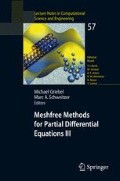Abstract
Recently, very intensive efforts have been devoted to develop meshless or element free methods that eliminate the need of element connectivity in the solution of PDEs. The motivation is to cut down modelling costs in industrial applications by avoiding the labor intensive step of mesh generation. In addition, these methods are particularly attractive in problems with moving interfaces since no remeshing is necessary.
Access this chapter
Tax calculation will be finalised at checkout
Purchases are for personal use only
Preview
Unable to display preview. Download preview PDF.
References
A. I. Fedoseyev, M. J. Friedman, and E. J. Kansa, Improved multiquadric method for elliptic partial differential equations via PDE collocation on the Boundary, Comput. Math. Appl., 43 (2002), 439–455.
B. Fornberg, T. A. Driscoll, G. Wright and R. Charles, Observation of the behavior of radial basis function approximations near boundaries, Comput. Math. Appl., 43 (2002), 473–490.
R. L. Hardy, Multiquadric equations of topography and other irregular surfaces, J. Geophys. Res., 176 (1971), 1905–1915.
C. A. Hieber and S. F. Shen, A finite-element/finite difference simulation of the injection-molding filling process, Journal of Non-Newtonian Fluid Mechanics, 7 (1979), 1–32.
E. J. Holm and H. P. Langtangen, A unified finite element model for the injection molding process, Comput. Methods Appl. Mech. Engrg., 178 (1999), 413–429.
E. J. Kansa, Multiquadrics - a scattered data approximation scheme with applications to computational fluid-dynamics. I. Surface approximations and partial derivative estimates, Comput. Math. Appls., 19 (1990), 127–145.
E. J. Kansa, Multiquadrics - a scattered data approximation scheme with applications to computational fluid-dynamics. II. Solutions to parabolic, hyperbolic and elliptic partial differential equations, Comput. Math. Appls., 19 (1990), 147–161.
T. H. Kwon and J. B. Park, Finite element analysis modeling of powder injection molding filling process including yield stress and slip phenomena, Polymer Engineering and Science, 35 (1995), 741–753.
J. Moody and C. J. Daken, Fast learning in networks of locally-tuned processing units, Neural Comput., 1 (1989), 281–294.
W. Noh and PC. Woodward, A simple line interface calculation, Proc. 5th Int. Conf. on Fluid Dynamics, Eds. A.I. vn de Vooran and P.J. Zandberger, Springer-Verlag (1976).
S. Osher and J. A. Sethian, Fronts propagating with curvature dependent speed: algorithms based on Hamilton-Jacobi formulations, J. Comput. Phys., 79 (1988), 12–49.
S. Osher and R. Fedkiw, Level set methods and dynamic implicit surfaces, Springer-Verlag (2003).
J. A. Sethian, Level set methods and fast marching methods. Evolving interfaces in computational geometry, fluid mechanics, computer vision and materials science, Cambridge University Press (1999).
O. Verhoyen and F. Dupret, A simplified method for introducing the Cross viscosity law in the numerical simulation of Hele Shaw flow, Journal of Non-Newtonian Fluid Mechanics, 74 (1998), 25–46.
I. Babuška, U. Banerjee, and J. E. Osborn, Meshless and Generalized Finite Element Methods: A Survey of Some Major Results, Meshfree Methods for Partial Differential Equations (M. Griebel and M. A. Schweitzer, eds.), Lecture Notes in Computational Science and Engineering, vol. 26, Springer, 2002, pp. 1–20.
T. Belytschko, Y. Y. Lu, and L. Gu, Element-free Galerkin methods, Int. J. Numer. Meth. Engrg. 37 (1994), 229–256.
D. Braess, Finite elements: Theory, fast solvers, and applications in solid mechanics, Cambridge University Press, 2001.
M. Griebel and M. A. Schweitzer (eds.), Meshfree Methods for Partial Differential Equations, Lecture Notes in Computational Science and Engineering, vol. 26, Springer, 2002
M. Griebel and M. A. Schweitzer (eds.), Meshfree Methods for Partial Differential Equations II, Lecture Notes in Computational Science and Engineering, vol. 43, Springer, 2005.
Author information
Authors and Affiliations
Editor information
Editors and Affiliations
Rights and permissions
Copyright information
© 2007 Springer
About this chapter
Cite this chapter
Bernal, F., Kindelan, M. (2007). An RBF Meshless Method for Injection Molding Modelling. In: Griebel, M., Schweitzer, M.A. (eds) Meshfree Methods for Partial Differential Equations III. Lecture Notes in Computational Science and Engineering, vol 57. Springer, Berlin, Heidelberg. https://doi.org/10.1007/978-3-540-46222-4_3
Download citation
DOI: https://doi.org/10.1007/978-3-540-46222-4_3
Publisher Name: Springer, Berlin, Heidelberg
Print ISBN: 978-3-540-46214-9
Online ISBN: 978-3-540-46222-4
eBook Packages: Mathematics and StatisticsMathematics and Statistics (R0)

